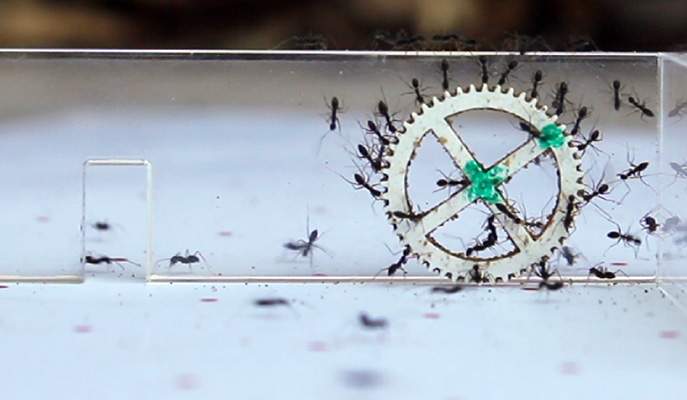עיתונאיות ועיתונאים, הירשמו כאן להודעות לעיתונות שלנו
הירשמו לניוזלטר החודשי שלנו:

Humans cooperate to move heavy objects – whether they are lifting stones for the building of a pyramid or just moving the fridge. The only other creature known to cooperate in this way to move heavy objects is the ant. Ants not only move objects many times their size, but in nature they also succeed in maneuvering those objects around, above or through obstacles in their path. New research that was recently published in PLoS Computational Biology shows that ants use simple behavioral rules that can be modeled mathematically to get the food they find back to the nest. By randomly switching between two behaviors, they are able to overcome nearly any obstruction in their way.
Humans coordinate their efforts through communication, but ants, it seems, have a different mechanism for communal work. In previous research in the lab of Prof. Nir Gov of the Chemical and Biological Physics Department and that of Dr. Ofer Feinerman of the Physics of Complex Systems Department – who maintains an “ant lab” in the Weizmann Institute of Science – the researchers discovered a sort of mechanical means of decision making. Each ant feels the force exerted by the other ants and adapts its own activity accordingly. “If an ant feels the piece of food moving away from it – that is, it is in the rear – it will lift. But if it feels that piece of food moving toward it, so that is in the lead, it will pull. In other words, the individual response of each ant contributes to the efficient movement of the group as a whole,” explains Gov.

In the new study, the researchers asked whether this simple means of organizing a group effort helps ants get their food crumbs through cracks in a wall or branches blocking the way to their nest. Led by research student Jonathan Ron in Gov’s group, the scientists first created a mathematical model to simulate the behavior of ants encountering an obstacle with a narrow opening through which ants can pass, but not a larger object. These simulations predicted that the ants would randomly switch back and forth between two modes of action: They would alternately congregate near the opening, trying to force their food through to the other side or they would run off to the right or left, as if looking for a way around the obstacle. Gov: “The model was based on the same simple rules the ants use to move an object freely – lift or pull, according to the forces they feel. There is no ant that says: ‘Hey, how do we get around this wall?’ The ants in the simulation just did what ants do best, as in free movement. So the problem is ‘solved’ by the collective, with no individual ant ‘realizing’ the problem at hand.”
There is no ant that says: ‘Hey, how do we get around this wall?
According to the model, the size of the ant group that encircles the piece of food determines which means of action will be more dominant. A smaller group that is carrying a small food item, will spend more time near the opening; a larger group is more likely to run to and fro along the obstacle. By this behavior, the ants increase their chances of squeezing the small food item through the narrow opening or finding a detour if the piece of food is too large.
The researchers then tested the predictions of their model in experiments with ants carrying different-sized objects. When they encountered a narrow opening in a barrier that was too small to admit their object, the ants, indeed switched randomly back and forth between the two modes, as the model had predicted. And when the object was smaller, the ants did – again, as predicted – spend more time near the opening. “The object we gave them couldn’t be compressed, but the ants managed to turn it on its side and almost got it through. Had it been a worm or a beetle – something more flexible – they might have succeeded,” says Gov.
The group is currently planning more complex tests involving the group behavior of ants carrying food, putting more and different obstacles in their way to mimic natural terrain.
A small group of ants spends more time near the opening
In a larger group, more ants run to and fro
Using a simple "mathematical formula," the ants maneuver the item around the obstacle
Also participating in this research were Dr. Itai Pinkoviezky, a former student in Gov’s group, and Staff Scientist Dr. Ehud Fonio in Feinerman’s lab.
Dr. Ofer Feinerman's research is supported by the Clore Center for Biological Physics; the Clore - Israel Foundation; the estate of Rachmiel Ramon Bloch; and the European Research Council. Dr. Feinerman is the incumbent of the Shlomo and Michla Tomarin Career Development Chair.
Prof. Nir Gov is the incumbent of the Lee and William Abramowitz Professorial Chair of Biophysics.